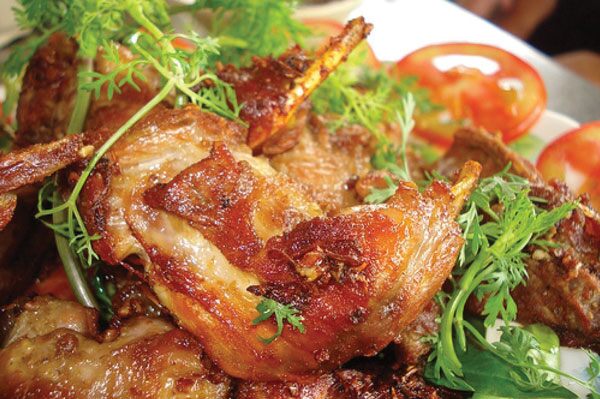Bats are the only flying mammals, and while they may resemble rodents, their wings are membranous. They are often perceived as ugly and frightening, preferring to hunt at night.
It may come as a surprise that in Dong Nai, Vietnam, bats are considered a delicacy. Locals share that there are various species of bats, but the fruit bat and the sen bat are commonly consumed.

Despite their unappealing odor, bats are a renowned specialty in Dong Nai.
The fruit bat, also known as the crow bat, can weigh up to 1.6 kg. They are typically spotted on moonlit nights and require a slingshot for capture. This species is meatier, with sweet and firm flesh.
On the other hand, sen bats are smaller, resembling sparrows in size, and are often seen hovering over rural fields at dusk, feeding on mosquitoes. Both types of bats emit an unpleasant odor, yet they are highly sought-after ingredients for a unique drinking snack in Dong Nai.
Preparing and cooking bats is a intricate process, typically handled by experienced individuals. Freshly caught bats are foul-smelling and have an intimidating appearance, testing the composure of those handling them for the first time.
To ensure the meat retains its sweetness and fragrance, specific butchering techniques must be employed. Washing the bat meat excessively is not recommended. Instead, a skilled handler will pluck the wings, peel the skin, and carefully remove the entrails to prepare the meat for cooking.

Bat meat is sweet and flavorful, but the preparation and cleaning process is intricate.
Bat meat can be transformed into a variety of dishes, including braised bat in coconut juice, bat and cabbage salad, bat spring rolls dipped in a sweet and sour fish sauce, grilled bat in soybean paste, or grilled on a boat stove. In Dong Nai’s restaurants and eateries, bat meat is proudly featured on the menu for guests.
While the name of this dish may initially evoke hesitation, those brave enough to try it will be captivated by the unique and delectable flavor of bat meat.
Mr. Ngoc, a restaurant owner in Trang Bom, Dong Nai, shares his insights: “Bat meat has a distinct, hearty flavor and is especially nutritious and cooling. Our customers particularly enjoy ‘dơi xào lăn,’ a stir-fried bat dish with lemongrass and chili. The bat meat is cut into small pieces, resulting in a combination of tender and crispy textures. The dish is characterized by a sweet and spicy flavor with a hint of nuttiness from the lemongrass and chili. For a more elaborate dish, bat meat can also be minced and used in a porridge.”

Bat meat can be prepared in a variety of delicious dishes, favored by locals and visitors alike.
Mr. Ngoc adds that while bat meat is occasionally sold in rural markets for around 120,000 VND per kg, it is not commonly found. Most often, it is supplied directly to restaurants and eateries by local hunters.
Historically, bat meat was a humble dish enjoyed by rural communities. However, as urban dwellers began seeking unique and exotic culinary experiences, bat meat gained popularity, intriguing adventurous foodies.
The Ultimate Superfood Fish: A Delicate, Nutritious, and Heart-Healthy Catch with Cancer-Fighting Powers – Now Affordable and Widely Available at Your Local Market.
Sea bass is a freshwater fish with delicate flesh and a rich nutritional profile. This affordable fish, widely available in Vietnam, boasts an array of health benefits, particularly for cardiovascular health and cancer prevention. With its tender meat and abundance of nutrients, sea bass is a delicious and wholesome addition to any meal.







































